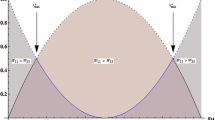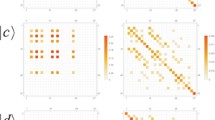Abstract
Quantum correlations (QCs) in some separable states have been proposed as a key resource for certain quantum communication tasks and quantum computational models without entanglement. In this paper, a family of nine-parameter separable states, obtained from arbitrary mixture of two sets of bi-qubit product pure states, is considered. QCs in these separable states are studied analytically or numerically using four QC quantifiers, i.e., measurement-induced disturbance (Luo in Phys Rev A77:022301, 2008), ameliorated MID (Girolami et al. in J Phys A Math Theor 44:352002, 2011),quantum dissonance (DN) (Modi et al. in Phys Rev Lett 104:080501, 2010), and new quantum dissonance (Rulli in Phys Rev A 84:042109, 2011), respectively. First, an inherent symmetry in the concerned separable states is revealed, that is, any nine-parameter separable states concerned in this paper can be transformed to a three-parameter kernel state via some certain local unitary operation. Then, four different QC expressions are concretely derived with the four QC quantifiers. Furthermore, some comparative studies of the QCs are presented, discussed and analyzed, and some distinct features about them are exposed. We find that, in the framework of all the four QC quantifiers, the more mixed the original two pure product states, the bigger QCs the separable states own. Our results reveal some intrinsic features of QCs in separable systems in quantum information.





Similar content being viewed by others
References
Einstein, A., Podolsky, B., Rosen, N.: Can quantum-mechanical description of physical reality be considered complete? Phys. Rev. 47, 777 (1935)
Bohr, N.: Can quantum-mechanical description of physical reality be considered complete? Phys. Rev. 48, 696 (1935)
Ekert, A.: Quantum cryptography based on bell’s theorem. Phys. Rev. Lett. 67, 661 (1991)
Bennett, C.H., Brassard, G., Mermin, N.D.: Quantum cryptography without bell’s theorem. Phys. Rev. Lett. 68, 557 (1992)
Long, G.L., Liu, X.S.: Theoretically efficient high-capacity quantum-key-distribution scheme. Phys. Rev. A 65, 032302 (2002)
Bennett, C.H., Brassard, G., Crepeau, C., et al.: Teleporting an unknown quantum state via dual classical and Einstein-Podolsky-Rosen channels. Phys. Rev. Lett. 70, 1895 (1993)
Zhang, Z.J., Liu, Y.M.: Perfect teleportation of arbitrary n-qudit states using different quantum channels. Phys. Lett. A 372, 28 (2007)
Cheung, C.Y., Zhang, Z.J.: Criterion for faithful teleportation with an arbitrary multiparticle channel. Phys. Rev. A 80, 022327 (2009)
Bouwmeester, D., et al.: Experimental quantum teleportation. Nature 390, 575 (1997)
Furusawa, A., et al.: Unconditional quantum teleportation. Science 282, 706 (1998)
Boschi, D., et al.: Experimental realization of teleporting an unknown pure quantum state via dual classical and Einstein-Podolsky-Rosen channels. Phys. Rev. Lett. 80, 1121 (1998)
Hillery, M., Bužek, V., Berthiaume, A.: Quantum secret sharing. Phys. Rev. A 59, 1829 (1999)
Xiao, L., Long, G.L., Deng, F.G., Pan, J.W.: Efficient multiparty quantum-secret-sharing schemes. Phys. Rev. A 69, 052307 (2004)
Zhang, Z.J., Man, Z.X.: Multiparty quantum secret sharing of classical messages based on entanglement swapping. Phys. Rev. A 72, 022303 (2005)
Li, T., Ren, B.C., Wei, H.R., Hua, M., Deng, F.G.: High-efficiency multipartite entanglement purification of electron-spin states with charge detection. Quantum Inf. Process. 12, 855 (2013)
Bennett, C.H., DiVincenzo, D.P., Shor, P.W., Smolin, J.A.: Remote state preparation. Phys. Rev. Lett. 87, 077902 (2001)
Lo, H.K.: Classical-communication cost in distributed quantum-information processing: a generalization of quantum-communication complexity. Phys. Rev. A 62, 012313 (2000)
Yu, C.S., Song, H.S., Wang, Y.H.: Remote preparation of a qudit using maximally entangled states of qubits. Phys. Rev. A 73, 022340 (2006)
Deng, F.G., Long, G.L., Liu, X.S.: Two-step quantum direct communication protocol using the Einstein-Podolsky-Rosen pair block. Phys. Rev. A 68, 042317 (2003)
Zhu, A.D., Xia, Y., Fan, Q.B., Zhang, S.: Secure direct communication based on secret transmitting order of particles. Phys. Rev. A 73, 022338 (2006)
Li, Q.T., Cui, J.L., Wang, S.H., Long, G.L.: Study of a monogamous entanglement measure for three-qubit quantum systems. Quantum Inf. Process. 15, 2405 (2016)
Munro, W.J., Van, M.R., et al.: High-bandwidth hybrid quantum repeater. Phys. Rev. Lett. 101, 040502 (2008)
Zukowski, M., Zeilinger, A., et al.: “Event-Ready-Detectors” bell experiment via entanglement swapping. Phys. Rev. Lett. 71, 4287 (1993)
Goebel, A.M., Wagenknecht, C., Zhang, Q., et al.: Multistage entanglement swapping. Phys. Rev. Lett. 101, 080403 (2008)
Branciard, C., Gisin, N., Pironio, S.: Characterizing the nonlocal correlations created via entanglement swapping. Phys. Rev. Lett. 104, 170401 (2010)
Ollivier, H., Zurek, W.H.: Quantum discord: a measure of the quantumness of correlations. Phys. Rev. Lett. 88, 017901 (2001)
Luo, S.: Using measurement-induced disturbance to characterize correlations as classical or quantum. Phys. Rev. A 77, 022301 (2008)
Modi, K., Paterek, T., Son, W., Vedral, V., Williamson, M.: Unified view of quantum and classical correlations. Phys. Rev. Lett. 104, 080501 (2010)
Dakic, B., Vedral, V., Brukner, C.: Necessary and sufficient condition for nonzero quantum discord. Phys. Rev. Lett. 105, 190502 (2010)
Luo, S., Fu, S.: Geometric measure of quantum discord. Phys. Rev. A 82, 034302 (2010)
Zhou, T., Cui, J., Long, G.L.: Measure of nonclassical correlation in coherence-vector representation. Phys. Rev. A 84, 062105 (2011)
Girolami, D., Paternostro, M., Adesso, G.: Faithful nonclassicality indicators and extremal quantum correlations in two-qubit states. J. Phys. A Math. Theor. 44, 352002 (2011)
Rulli, C.C., Sarandy, M.S.: Global quantum discord in multipartite systems. Phys. Rev. A 84, 042109 (2011)
Zhang, F.L., Chen, J.L.: Irreducible multiqutrit correlations in Greenberger-Horne-Zeilinger-type states. Phys. Rev. A. 84, 062328 (2011)
Ye, B.L., Liu, Y.M., Chen, J.L., Liu, X.S., Zhang, Z.J.: Analytic expressions of quantum correlations in qutrit Werner states. Quantum Inf. Process. 12, 2355 (2013)
Tang, H.J., Liu, Y.M., Chen, J.L., Ye, B.L., Zhang, Z.J.: Analytic expressions of discord and geometric discord in Werner derivatives. Quantum Inf. Process. 13, 1331 (2014)
Datta, A., Shaji, A., Caves, C.M.: Quantum discord and the power of one qubit. Phys. Rev. Lett. 100, 050502 (2008)
Lanyon, B.P., Barbieri, M., Almeida, M.P., White, A.G.: Experimental quantum computing without entanglement. Phys. Rev. Lett. 101, 200501 (2008)
Madhok, V., Datta, A.: Interpreting quantum discord through quantum state merging. Phys. Rev. A 83, 032323 (2011)
Dakic, B., Lipp, Y.O., Ma, X., et al.: Quantum discord as resource for remote state preparation. Nat. Phys. 8, 666 (2012)
Li, B., Fei, S.M., Wang, Z.X., Fan, H.: Assisted state discrimination without entanglement. Phys. Rev. A 85, 022328 (2012)
Sarandy, M.S.: Classical correlation and quantum discord in critical systems. Phys. Rev. A 80, 022108 (2009)
Lloyd, S.: Quantum search without entanglement. Phys. Rev. A 61, 010301 (1999)
Meyer, D.A.: Sophisticated quantum search without entanglement. Phys. Rev. Lett. 85, 2014 (2000)
Modi, K., Brodutch, A., Cable, H., Paterek, T., Vedral, V.: The classical-quantum boundary for correlations: discord and related measures. Rev. Mod. Phys. 84, 1655 (2012)
Werlang, T., Souza, S., Fanchini, F.F., Villas, B.C.J.: Robustness of quantum discord to sudden death. Phys. Rev. A 80, 024103 (2009)
Wei, H.R., Ren, B.C., Deng, F.G.: Geometric measure of quantum discord for a two-parameter class of states in a qubitCqutrit system under various dissipative channels. Quantum Inf. Process. 12, 1109 (2013)
Ren, B.C., Wei, H.R., Deng, F.G.: Correlation dynamics of a two-qubit system in a bell-diagonal state under non-identical local noises. Quantum Inf. Process. 13, 1175 (2014)
Guo, J.L., Li, H., Long, G.L.: Decoherent dynamics of quantum correlations in qubit–qutrit systems. Quantum Inf. Process. 12, 3421 (2013)
Li, B., Wang, Z.X., Fei, S.M.: Geometry for a class of two-qubit states. Phys. Rev. A 83, 022321 (2011)
Shi, M., Sun, C., Jiang, F., Yan, X., Du, J.: Optimal measurement for quantum discord of two-qubit states. Phys. Rev. A 85, 064104 (2012)
Wei, H.R., Ren, B.C., Deng, F.G.: Geometric measure of quantum discord for a two-parameter class of states in a qubit–qutrit system under various dissipative channels. Quantum Inf. Process. 12, 1109 (2013)
Giorgi, G.L., Bellomo, B., Galve, F., Zambrini, R.: Genuine quantum and classical correlations in multipartite systems. Phys. Rev. Lett. 107, 190501 (2011)
Giorda, P., Paris, M.G.A.: Gaussian quantum discord. Phys. Rev. Lett. 105, 020503 (2010)
Gessner, M., Laine, E.M., Breuer, H.P., Piilo, J.: Correlations in quantum states and the local creation of quantum discord. Phys. Rev. A 85, 052122 (2012)
Madsen, L.S., Berni, A., Lassen, M., Andersen, U.L.: Experimental investigation of the evolution of gaussian quantum discord in an open system. Phys. Rev. Lett. 109, 030402 (2012)
Zou, C., Chen, X., et al.: Photonic simulation of system-environment interaction: non-Markovian processes and dynamical decoupling. Phys. Rev. A 88, 063806 (2013)
Dajka, J., et al.: Swapping of correlations via teleportation with decoherence. Phys. Rev. A 87, 022301 (2013)
Lanyon, B.P., Jurcevic, P., Hempel, C., et al.: Experimental generation of quantum discord via noisy processes. Phys. Rev. Lett. 111, 100504 (2013)
Rana, S., Parashar, P.: Tight lower bound on geometric discord of bipartite states. Phys. Rev. A 85, 024102 (2012)
Debarba, T., Maciel, T.O., Vianna, R.O.: Witnessed entanglement and the geometric measure of quantum discord. Phys. Rev. A 86, 024302 (2012)
Montealegre, J.D., Paula, F.M., Saguia, A., Sarandy, M.S.: One-norm geometric quantum discord under decoherence. Phys. Rev. A 87, 042115 (2013)
Chang, L., Luo, S.: Remedying the local ancilla problem with geometric discord. Phys. Rev. A 87, 062303 (2013)
Miranowicz, A., Horodecki, P., Chhajlany, R.W., Tuziemski, J., Sperling, J.: Analytical progress on symmetric geometric discord: measurement-based upper bounds. Phys. Rev. A 86, 042123 (2012)
Xie, C.M., Liu, Y.M., Xing, H., Chen, J.L., Zhang, Z.J.: Quantum correlation swapping. Quantum Inf. Process. 14, 653 (2015)
Xie, C.M., Liu, Y.M., Chen, J.L., Zhang, Z.J.: Study of quantum correlation swapping with relative entropy methods. Quantum Inf. Process. 15, 809 (2016)
Cen, L.X., Li, X.Q., Shao, J.S., Yan, Y.J.: Quantifying quantum discord and entanglement of formation via unified purifications. Phys. Rev. A 83, 054101 (2011)
Xie, C.M., Liu, Y.M., Li, G.F., Zhang, Z.J.: A note on quantum correlations in Werner states under two collective noises. Quantum Inf. Process. 13, 2713 (2014)
Xie, C.M., Liu, Y.M., Chen, J.L., Yin, X.F., Zhang, Z.J.: Quantum entanglement swapping of two arbitrary bi-qubit pure states. Sci. China Phys. Mech. Astron. 59, 100314 (2016)
Acknowledgements
Authors are very grateful to the anonymous referees and the associated editor Dr. Michael Frey for their constructive and detailed suggestions. This work is supported by the National Natural Science Foundation of China (NNSFC) under Grant Nos. 11375011 and 11372122, the Natural Science Foundation of Anhui province under Grant No. 1408085MA12, and the 211 Project of Anhui University.
Author information
Authors and Affiliations
Corresponding author
Appendix 1 Analyses: \(\rho _{{ab}}\) are associated with \(\varrho _{{ab}}\) through local unitary transformations
Appendix 1 Analyses: \(\rho _{{ab}}\) are associated with \(\varrho _{{ab}}\) through local unitary transformations
State in Eq. (1) can be rewritten as
Firstly, by using the following transformations \(U_{1a}\) and \(U_{2b}\), which are local unitary operations performed on qubits a and b respectively,
one can get
Secondly, by performing the following local unitary transformations,
one can further get
The parameters \(\lambda _i\)’s are defined as following
Furthermore, defining
one can get
The parameters \(\omega _i\)’s are defined as following
Lastly, in Eq. (53), \( U_{{a}}^\dag U_{{b}}^\dag \ |\varphi _3\rangle _{{a}} \langle \varphi _3| |\varphi _4\rangle _{{b}}\langle \varphi _4|U_{{a}} U_{{b}}\) can be written as
where \(|\xi \rangle _{{a}}= \sqrt{\alpha } |0\rangle _{{a}} +\sqrt{1-\alpha } |1\rangle _{{a}}\) and \(|\zeta \rangle _{{b}}= \sqrt{\beta } |0\rangle _{{a}} +\sqrt{1-\beta } |1\rangle _{{a}}\) with
Finally, by defining
one can conclude that the concerned state \(\rho _{{ab}}\) in this paper are related with a kernel state \(\varrho _{{ab}}\) through local unitary transformations.
Rights and permissions
About this article
Cite this article
Xie, C., Liu, Y., Chen, J. et al. Quantum correlations in a family of bipartite separable qubit states. Quantum Inf Process 16, 71 (2017). https://doi.org/10.1007/s11128-017-1532-z
Received:
Accepted:
Published:
DOI: https://doi.org/10.1007/s11128-017-1532-z




